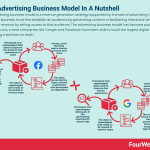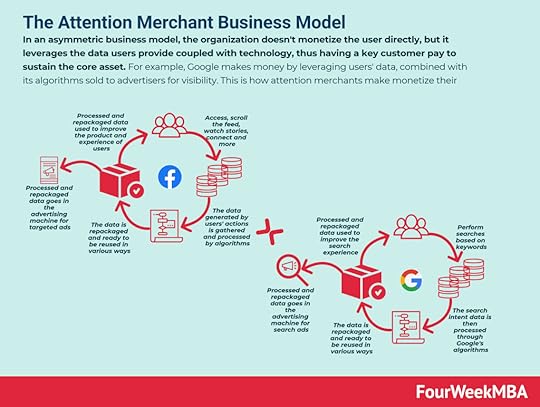What Is The Advertising Business Model? The Advertising Business Model In A Nutshell


The advertising business model is a revenue generation strategy supported by the sale of advertising. In general, a business must first establish an audience by generating content or facilitating interaction and then earn revenue by selling access to that audience. The advertising business model has become popular in the web era, where companies like Google and Facebook have been able to build the largest digital advertising machines on earth.
Understanding the advertising business modelThe advertising business model has long been associated with newspapers, magazines, radio, television, and any other medium where advertising revenue is critical to the survival of the business.
Today, the model is a staple of many online businesses, from eCommerce sites such as Amazon to search engines such as Google and everything in between. In most cases, the model is only successful if the business can generate large volumes of targeted traffic. Revenue in this context is generated in three main ways:
Advertisers pay website owners to display advertising on their site.Advertisers pay website owners to refer visitors to the advertiser’s website.Advertisers pay website owners to display advertising messages with the ability for the consumer to click through to their website.As more businesses monetize their content, website owners have tried to counter the rising prevalence of ad-blockers by serving native ads which mimic normal content. This, some suggest, has caused an arms race between consumers using ad-blockers and businesses hiding their content behind paywalls.
Despite recent conjecture that it may become obsolete, the advertising business model will continue to be a significant strategy moving forward. Once established, the model enables businesses to make money without the hassle of selling a product or a service. What’s more, advertisers are often willing to pay more for access to a highly targeted or engaged audience.
Four basic advertising strategiesWhile there are many ways a business can earn money from advertising, the following four categories cover the vast majority of advertisement models in the digital space:
Display advertisingMost of these are banner ads, which have been declining in popularity as consumers become more averse to them. These ads are small, digital billboards placed around content and can be animated or static. They are commonly used to depict a fast visual story that promotes brand identity, with revenue collected according to the cost-per-impression (CPM) model.
Video advertisingUnsurprisingly, video ads are now the predominant form of advertising because they are entertaining and can tell a brand story in a way that a banner ad never could. They are typically shown pre-roll, mid-roll, or post-roll in a video the consumer is already watching. Since they are relevant and contextual, the viewer is more open to watching them.
Mobile advertisingThese are optimized for mobile content consumption and include video, app, display, search, and social-based ads. Mobile advertising often works under the cost-per-lead model.
Native advertisingConsidered the least disruptive ads because they are incorporated into a piece of content. Like many video ads, native ads are relevant and contextual. They may take the form of videos, photos, or blog posts with a simple text link to the product manufacturer’s website. Google Adsense is one example of native advertising where advertisers pay website owners whenever their ads are clicked on by the user.
Key takeaways:The advertising business model is a revenue generation strategy supported by the sale of advertising. The business must first establish an audience by generating content or facilitating interaction and then earn revenue by selling access to that audience.The advertising business model is still relevant today as online consumers become more averse to traditional promotional strategies. What’s more, the strategy is attractive to website owners who want to monetize their audiences and earn revenue without the hassle of selling a product or service.There are four general advertising types under the advertising business model: display advertising, video advertising, mobile advertising, and native advertising. Many argue display advertising is now redundant as consumers become savvier and spend more of their time watching videos on smartphones.Read Next: Google Business Model, Facebook Business Model, Asymmetric Business Models, Attention-Based Business Models.
Connected Business Models Google is a platform, and a tech media company running an attention-based business model. As of 2020, Alphabet’s Google generated over $182 billion in revenues. Almost $147 billion came from Google Advertising products (Google Search, YouTube Ads, and Network Members sites). They were followed by over $21 billion in other revenues (comprising Google Play, Pixel phones, and YouTube Premium), followed by Google Cloud, which generated over $13 billion in 2020.
Google is a platform, and a tech media company running an attention-based business model. As of 2020, Alphabet’s Google generated over $182 billion in revenues. Almost $147 billion came from Google Advertising products (Google Search, YouTube Ads, and Network Members sites). They were followed by over $21 billion in other revenues (comprising Google Play, Pixel phones, and YouTube Premium), followed by Google Cloud, which generated over $13 billion in 2020. Facebook is an attention-based business model. As such, its algorithms condense the attention of over 2.4 billion users as of June 2019. Facebook advertising revenues accounted for $31.9 billion or 98.66% of its total revenues. Facebook Inc. has a product portfolio made of Instagram, Messenger, WhatsApp, and Oculus.
Facebook is an attention-based business model. As such, its algorithms condense the attention of over 2.4 billion users as of June 2019. Facebook advertising revenues accounted for $31.9 billion or 98.66% of its total revenues. Facebook Inc. has a product portfolio made of Instagram, Messenger, WhatsApp, and Oculus. In an asymmetric business model, the organization doesn’t monetize the user directly, but it leverages the data users provide coupled with technology, thus have a key customer pay to sustain the core asset. For example, Google makes money by leveraging users’ data, combined with its algorithms sold to advertisers for visibility.
In an asymmetric business model, the organization doesn’t monetize the user directly, but it leverages the data users provide coupled with technology, thus have a key customer pay to sustain the core asset. For example, Google makes money by leveraging users’ data, combined with its algorithms sold to advertisers for visibility.  In an asymmetric business model, the organization doesn’t monetize the user directly, but it leverages the data users provide coupled with technology, thus having a key customer pay to sustain the core asset. For example, Google makes money by leveraging users’ data, combined with its algorithms sold to advertisers for visibility. This is how attention merchants make monetize their business models.
In an asymmetric business model, the organization doesn’t monetize the user directly, but it leverages the data users provide coupled with technology, thus having a key customer pay to sustain the core asset. For example, Google makes money by leveraging users’ data, combined with its algorithms sold to advertisers for visibility. This is how attention merchants make monetize their business models. Main Free Guides:
Business ModelsBusiness CompetitionBusiness StrategyBusiness DevelopmentDigital Business ModelsDistribution ChannelsMarketing StrategyPlatform Business ModelsRevenue ModelsTech Business ModelsBlockchain Business Models FrameworkThe post What Is The Advertising Business Model? The Advertising Business Model In A Nutshell appeared first on FourWeekMBA.



